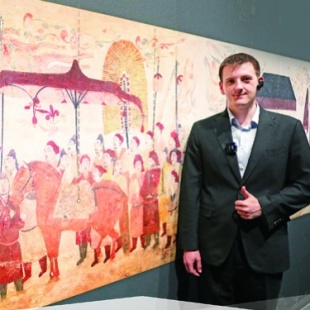The moral of China's timeless murals


A US youth visits the Taiyuan Northern Qi Dynasty Mural Museum, exploring ancient Chinese history and art through well-preserved murals, advanced technology, and a diverse artifact collection.
As I stepped into the Taiyuan Northern Qi Dynasty Mural Museum for the first time, I was filled with excitement. As a young person from the US, I knew I was standing on the doorstep of an adventure into the depths of ancient Chinese history and art.
Located in Taiyuan, the capital of North China's Shanxi province, the museum uniquely addresses the challenge of preserving ancient tomb mural sites. It is the first of its kind in China, according to Wang Jiang, the museum's curator.
"It's the first thematic museum built on the original site of mural tombs," said Wang.
At the heart of the museum was a collection of murals, ranging from vibrant depictions of daily life to mysterious scenes rich in symbolism, each showcasing the unparalleled artistry of the Northern Qi Dynasty (550-577) and its diverse culture.
One of the most impressive examples was the tomb of Xu Xianxiu (502-571), a respected official from the Northern Qi era. This tomb was famous for its incredibly well-preserved murals, covering an imposing area of 300 square meters. It provided a fascinating glimpse into his life, with scenes depicting him and his wife adorning the walls. These murals not only showcased the artistic talent of the time but also offered valuable insights into the lavish lifestyle enjoyed by the dynasty's elite.
As I wandered through the exhibition halls, I could not help but be drawn in by the stories told behind each brushstroke. Every color seemed to reflect the skill and imagination of the artists, captivating my attention.
As a relatively new museum, which opened its doors to the public in 2023, it employs advanced technology, such as VR (virtual reality), AR (augmented reality), and interactive digital art devices, to bring ancient murals to life.
By using these innovative technologies, the museum aims to provide visitors with an engaging historical journey, according to Wang.
"Digital displays, panels, and videos are used to interpret the stories behind the relics, immersing the audience in a tactile atmosphere to deepen their understanding of these treasures from both historical and artistic perspectives," he said.
I also had the chance to experience this cutting-edge technology firsthand. As I put on the VR headset and looked through the lenses, I was able to virtually enter the tomb of Xu Xianxiu and examine the intricate details of the murals up close, which, due to conservation efforts, was not possible to do physically. The murals on the inner walls of the tomb were clearly visible in 4K resolution, allowing me to engage more deeply with the works and the other artistic aspects of the exhibition.
Apart from murals, the museum also houses a diverse collection of artifacts from the Northern Qi period. These include tomb figurines, unique items like a pot shaped like a chicken, a sapphire ring adorned with gold, epitaphs and their covers, and glazed pottery bowls. Together, these treasures, along with the murals, provided a comprehensive view of Northern Qi society, shedding light on its material culture and social dynamics.
Wang also discussed the significance of the murals' portrayal of Western figures and attire, suggesting a history of vibrant East-West trade and interaction during the Northern Qi period.





































